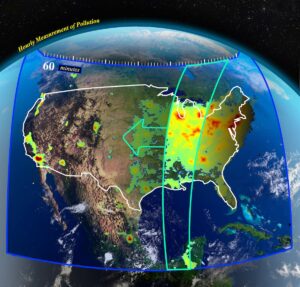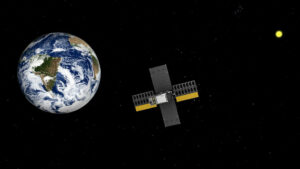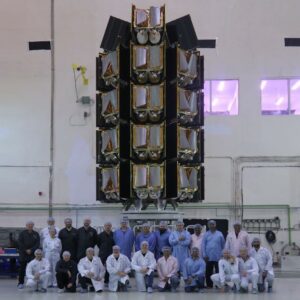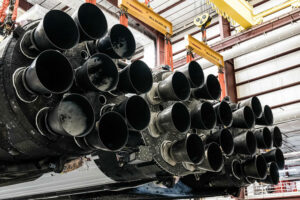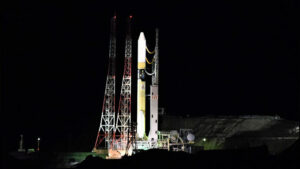
Closing out a 31-hour flight from a launch pad in Florida, a SpaceX Cargo Dragon capsule autonomously docked with the International Space Station Monday, delivering experiments, supplies, and fresh food to the complex.
The automated cargo freighter linked up with the forward port of the space station’s Harmony module at 10:30 a.m. EDT (1430 GMT), making contact with the outpost as it sailed 264 miles (424 kilometers) over Western Australia.
A few minutes later, the cargo ship retracted its docking ring, allowing 12 hooks to drive closed, creating a firm mechanical connection between the Dragon and the space station.
“Hard capture complete, and another excellent Dragon docking complete,” radioed Leslie Ringo, spacecraft communicator at NASA’s mission control in Houston.
“Congratulations to NASA and the SpaceX teams, and many thanks. No one has ever sent me a spaceship for my birthday before. I appreciate it,” replied astronaut Megan McArthur from the space station.
McArthur celebrated her 50th birthday Wednesday. She and crewmate Shane Kimbrough monitored the Dragon capsule’s final approach two the space station, ready to send commands for the supply ship to abort its rendezvous in the event of an emergency.
The Cargo Dragon capsule carried treats, such as ice cream, cheese, and fruit, for the space station’s seven-person crew. McArthur tweeted later Monday that she enjoyed a birthday dinner with her crewmates.
“My space brothers went all out: quesadillas and tortilla-pizzas with real cheese! Cookie decorating! Cake with chocolate ‘candles’! We haven’t unpacked the ice cream yet, so I guess that means a second party?” she tweeted.
What a great birthday dinner with my Expedition 65 crew mates! My #SpaceBrothers went all out: quesadillas and tortilla-pizzas with real cheese! Cookie decorating! Cake with chocolate “candles”! We haven’t unpacked the ice cream yet, so I guess that means a 2nd party? 🌮🍕🎂 pic.twitter.com/h0D85fz6ei
— Megan McArthur (@Astro_Megan) 30. augusztus 2021.
The Cargo Dragon capsule delivered 4,866 pounds (2,207 kilograms) of supplies and experiments. The mission, known as CRS-23, marks SpaceX’s 23rd resupply flight to the space station since 2012 under contract to NASA.
It is the third flight of an upgraded variant of SpaceX’s Dragon cargo ship based the company’s human-rated capsule. It’s the second mission for this particular spacecraft, which previously flew to the station in December 2020.
Besides fresh food, the Dragon supply freighter delivered an array of technology demonstration, materials science, and biomedical experiments to the space station. The station astronauts plan to unpack more than a ton of science hardware from the Dragon spacecraft’s pressurized cabin.
Ezek közé tartozik a GITAI Japan Inc., egy japán cég kisméretű robotkarja, amely olyan űrbeli feladatokat mutat be, amelyek a jövőbeni robotok kifejlesztéséhez vezethetnek, amelyek hosszú távú űrmissziókban segítik az űrhajósokat. A kar végigfut a bemutatókon, beleértve a kapcsoló- és kábelműveleteket, valamint az űrben végzett összeszerelési kísérleteket, a Bishop tulajdonában lévő Nanoracks légzsilipben.
A GITAI szerint a feladatok egy része autonóm lesz, míg másokat a Nanoracks houstoni létesítményéből távműködtetnek majd.
„Ez a technológiai bemutató azt a célt szolgálja, hogy megmutassa a világnak, hogy végre elérhetőek az űrbeli automatizáláshoz szükséges képességek” – mondta Toyotaka Kozuki, a GITAI japán technológiai igazgatója. "Olcsó és biztonságosabb munkaerő-forrást biztosít az űrben, megnyitva az ajtót az űr valódi kereskedelmi forgalomba hozatalához."

A misszióhoz tartozik egy kísérleti tárhelycsomag is, a Faraday Research Facility. A ProXops nevű houstoni cég által kifejlesztett létesítményt űrhajósok helyezik be az űrállomás egyik tudományos állványába.
Ezen a repülésen a létesítmény a Houston Methodist Research Institute kísérletét végzi egy beültethető, távirányítású gyógyszeradagoló rendszer tesztelésére. A tudósok szerint a kísérlet alternatívát kínálhat a terjedelmes infúziós pumpák helyett a Földön élő betegek krónikus betegségeinek kezelésében.
A NASA szerint a létesítmény két oktatási kísérletnek is otthont ad, amelyeket az űrállomáson kell végrehajtani, köztük egy cserkészlány csapat részvételével a földön.
The Cargo Dragon also ferried samples to the space station for a NASA materials science experiment. The Materials International Space Station Experiment, or MISSE, investigations use a platform outside the complex to test the resilience of specimens in the harsh environment of low Earth.
NASA said the samples on the CRS-23 mission include tests of concrete, spacecraft materials, fiberglass composites, thin-film solar cells, radiation protection materials, and more.
A Cargo Dragon túlnyomásos rekeszében több CubeSat is található. Az elkövetkező hetekben és hónapokban robotszerűen telepítik őket az űrállomáson kívülre.
The resupply mission launched aboard a Falcon 9 rocket Sunday at 3:14 a.m. EDT (0714 GMT) from NASA’s Kennedy Space Center in Florida.
A Cargo Dragon kapszula várhatóan több mint egy hónapig az űrállomáson marad. A küldetés végén az űrszonda kiköt, és több tonnányi rakománnyal tér vissza a Földre, hogy ejtőernyővel lecsaphasson Florida partjainál.
E-mail a szerző.
Kövesse Stephen Clarkot a Twitteren: @StephenClark1.
- "
- 2020
- 9
- Minden termék
- lehetővé téve
- ARM
- űrhajós
- Ausztrália
- Automatizált
- Automatizálás
- autonóm
- Szállítmány
- fő
- Főmérnöke
- zárt
- érkező
- kereskedelmi
- vállalat
- szerződés
- aprósütemény
- Krém
- létrehozása
- hitel
- átadó
- kézbesítés
- Fejlesztés
- Sárkány
- gyógyszer
- nevelési
- Környezet
- esemény
- kísérlet
- Objektum
- sólyom
- Falcon 9
- Végül
- Cég
- repülés
- Florida
- élelmiszer
- Előre
- friss
- jövő
- nagy
- hardver
- Összhang
- tárhely
- HTTPS
- ICE
- jégkrém
- Inc.
- Beleértve
- infúzió
- Nemzetközi
- nemzetközi Űrállomás
- IT
- Japán
- munkaerő
- indít
- vezet
- Gyártás
- anyagok
- Megan
- Küldetés
- hétfő
- hónap
- Nasa
- ajánlat
- Tiszt
- Művelet
- Egyéb
- betegek
- emelvény
- font
- védelem
- szivattyúk
- Sugárzás
- kutatás
- Gyűrű
- robotok
- futás
- Tudomány
- tudósok
- Megosztás
- kicsi
- So
- nap
- Hely
- űrállomás
- űrhajó
- SpaceX
- nyilatkozat
- kínálat
- kapcsoló
- rendszer
- Technológia
- teszt
- tesztek
- tonna
- Tónus
- kezelésére
- kezeli
- csipog
- világ


